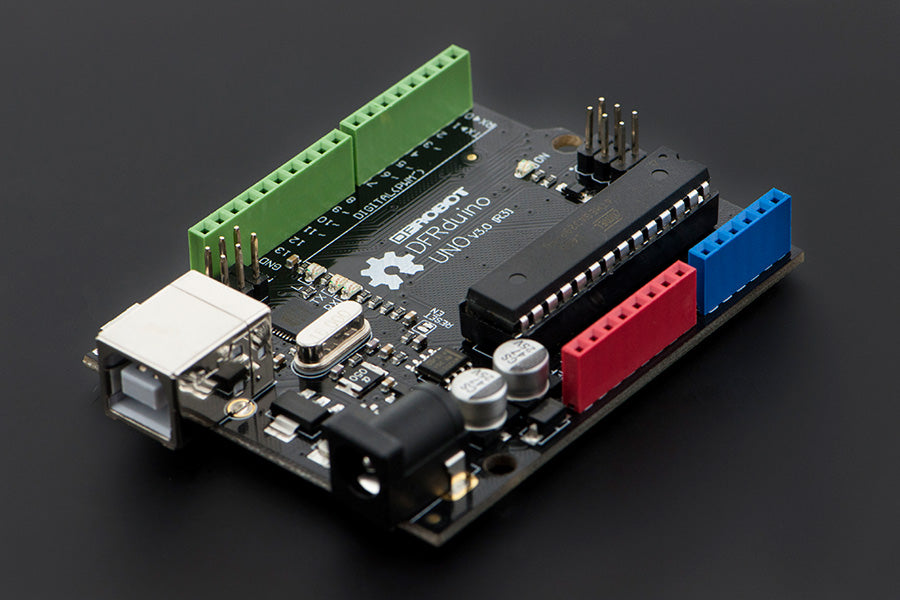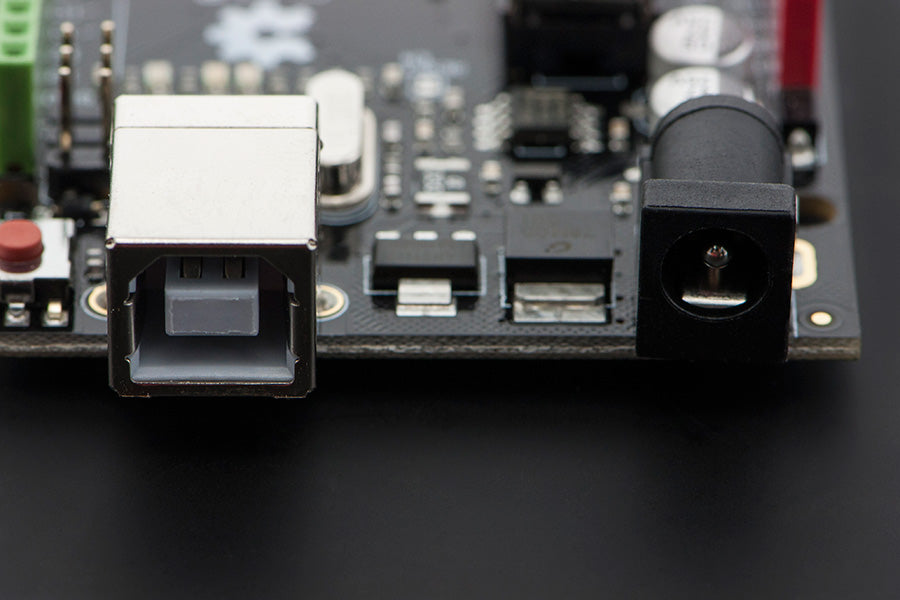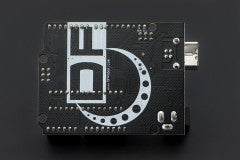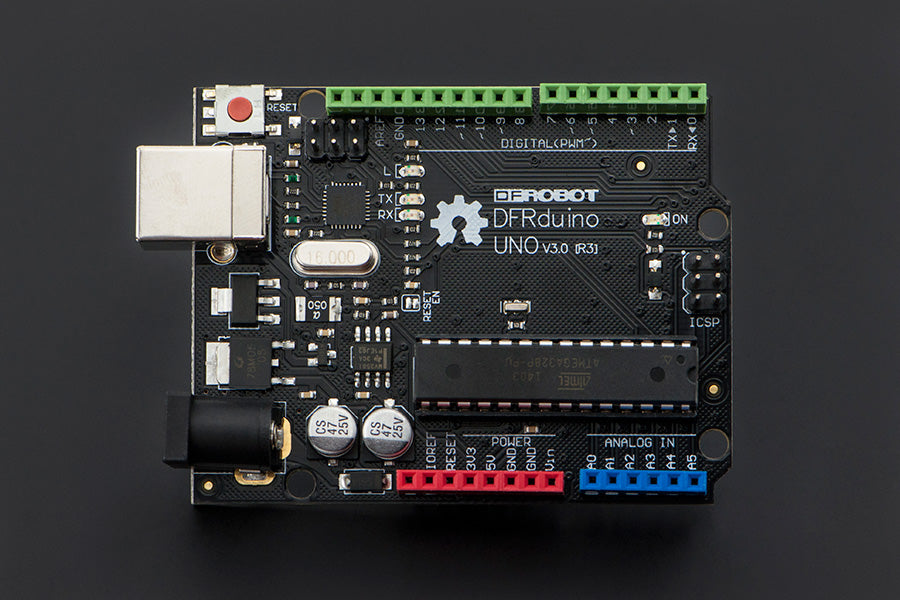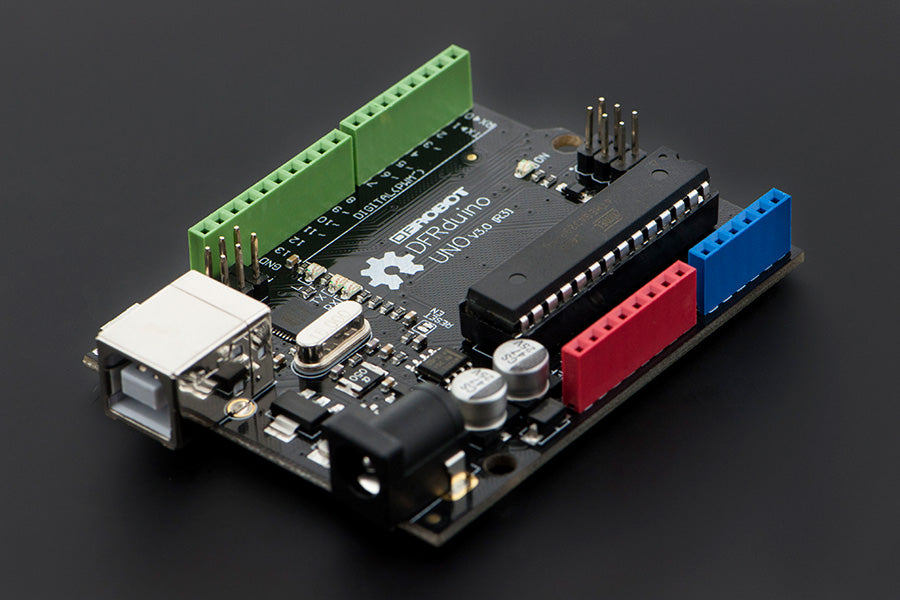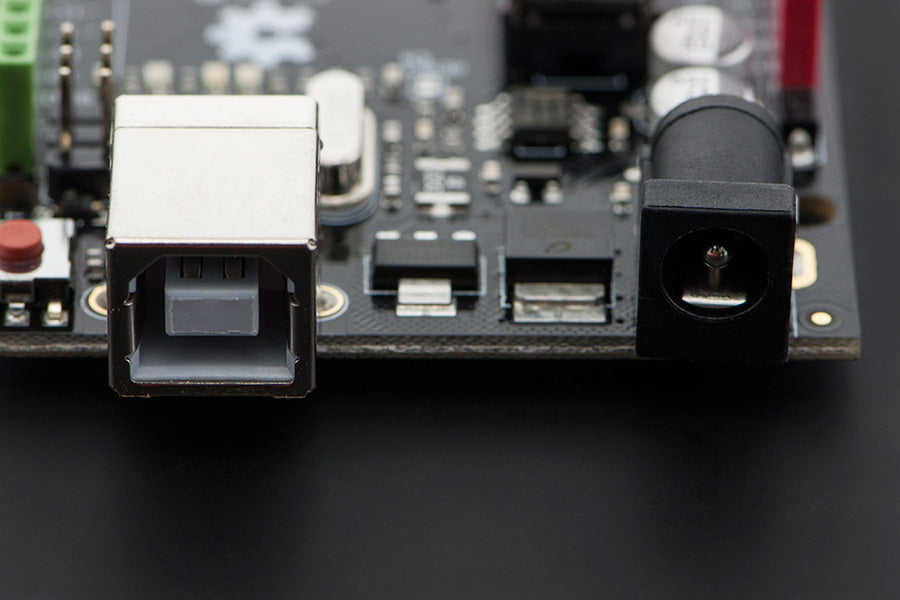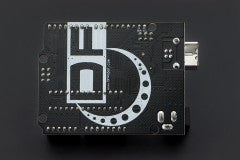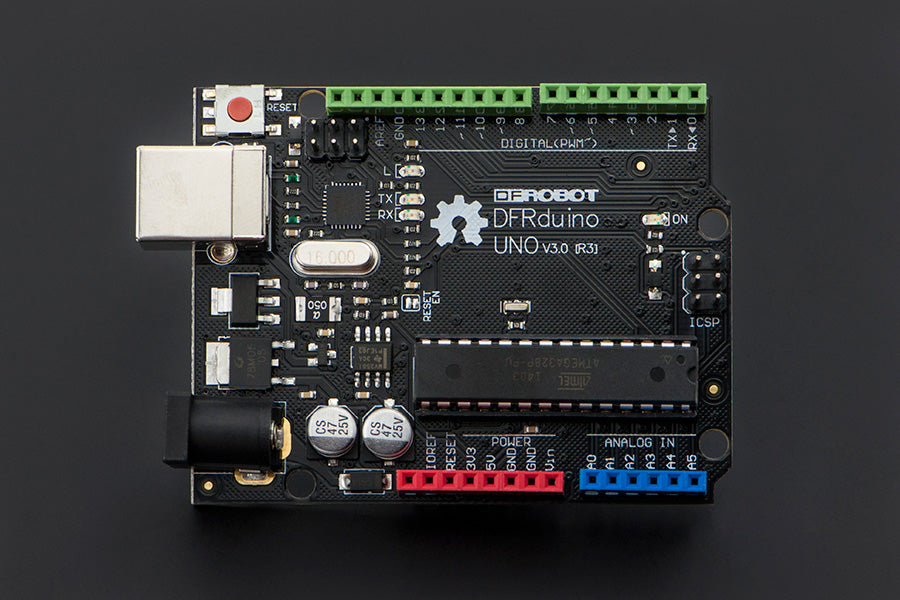Uno R3 by DFRobot with Arduino -
DFRduino Uno V3.0 from DFRobot is a physical world computing board of small size for academics or development. It is a simple microcontroller board fully compatible with Arduino UNO R3 and Arduino IDE open-source development environment. This environment implements the Processing / Wiring language. Arduino can be used to develop stand-alone interactive objects or can be connected to software on your computer (e.g. Flash, Processing, MaxMSP). The open-source IDE can be downloaded for free (currently for Mac OS X, Windows, and Linux).This board features the ATmega16U2 programmed as a USB-to-serial converter. A bonus is that our DFRduino is still using the DIP package AVR Chip. You could remove it to update or reprogram the chip's firmware, or even place it on a finished, more compact project. The cool thing about our new DFRduino microcontroller is that the headers use different colors to feature I/O ports of different types:
- Red for Power Section.
- Blue for Analog I/O.
- Green for Digital I/O.
These colors match our sensor cables. This makes it really easy to figure out where to connect sensors or to identify which side is Analog (blue) or Digital (green).
The Arduino Uno is a microcontroller board based on the ATmega328. It has 14 digital input/output pins (of which 6 can be used as PWM outputs), 6 analog inputs, a 16 MHz crystal oscillator, a USB connection, a power jack, an ICSP header, and a reset button. It contains everything needed to support the microcontroller; simply connect it to a computer with a USB cable or power it with an AC-to-DC adapter or battery to get started.
This board added SDA and SCL pins that are near to the AREF pin and two other new pins placed near to the RESET pin, the IOREF that allow the shields to adapt to the voltage provided from the board. In the future, shields will be compatible both with the board that uses the AVR, which operate with 5V, and with the Arduino Due which operates with 3.3V. The second one is a not-connected pin, that is reserved for future purposes.
SPECIFICATION
Microcontroller: ATmega328 (DIP Package)
Operating Voltage: 5V
Input Voltage (recommended): 7 ~ 12V
Input Voltage (limits): 6 ~ 20V
Digital I/O Pins: 14 (of which 6 provide PWM output)
Analog Input Pins: 6
DC Current per I/O Pin: 40 mA
DC Current for 3.3V Pin: 50 mA
Flash Memory: 32 KB of which 2KB is used by the bootloader
SRAM: 2 KB (ATmega328)
EEPROM: 1 KB (ATmega328)
Clock Speed: 16 MHz
Size: 75 x54 x15 mm
Environment Friendly: Rohs Compliance
DFRobot Uno R3 with Arduino – Product Description
Technological advancement is rapid in the current era of digitization. Computing devices come to the foray with high-tech specifications and more advanced features. In the world of Arduino projects,we come across several inventions every other day to let users embrace projects with innovation and applicability. The UNO R3 by DFRobot is such an invention with an open-source mechanism. It is a microcontroller board that is based on the ATmega 328 chip.
When it comes to analyzing the physical structure and formation, the board integrates the following circuits:
- 14 digital input/output pins
- USB connection port
- 16 MHz onboard ceramic resonator
- Onboard DC power jack
- 6 analog input pins
- An ICSP header
- A microcontroller reset button
Overall, the board hosts every single worthful unit that is required to support the microcontroller. Users will embed the project with Arduino using the open-source infrastructure of the board. Also, it isn’t rocket science to use the board since it is quite simpler and straightforward to connect the unit with the computer using a USB cable. Moreover, you can also use a DC adapter to power the board or battery to commence with operations.
The manufacturer always keeps the previous edition in mind while drafting the latest combination. Therefore, the advanced UNO R3 by DFRobot carries several elements different from the earlier edition. The latest development doesn’t use the FTDI USB-to-Serial Driver chip. Alongside, it unites the Atmega16U2Atmega8U2 up to version R2 that is further programmed as a USB-to-Serial converter. The more creative prospect related to this assembly is that it can be powered using the USB connection along with the external power supply. Well, it also delivers the flexibility to select the power source automatically without human intervention.
Arduino UNO R3 Brings Multiple Input Parameters!
As discussed above, the UNO R3 board features a USB and external DC adapter for powering the device.The external or non-USB power source can come either from a battery or AC-to-DC adapter. It facilitates users to connect the adapter by plugging a 2.1mm center positive plug into the power jack of the board. Further, a battery can be inserted in the GND and VIN pin headers of the power connector.
The Arduino board can work exceptionally well on an external supply of 6 to 20 volts. In case it is supplied with less than 7V, the 5V pin is likely to supply less than 5V to result in an unstable board. On the contrary, if you use more than 12V, a user may find the voltage regulator to be overheated and damaged. Hence, the recommended range always stays between 5V and 12V for Arduino UNO consideration.
Features –
- Operating Voltage: 5V
- Analog Input Pins: 6
- Clock Speed: 16 MHz
- DC Current: 40mA
- Applicable in DIY project prototyping
- Useful for learning AVR programming
- Perfect for entry-level circuit designing
- Helpful in constructing various projects that need a code-based control
- SRAM: 2KB
- EEPROM: 1KB
- Digital I/O pins: 14
- Flash Memory: 32KB
Uno R3 by Dfrduino Arduino Compatible
Uno R3 by Dfrduino Arduino Compatible
Out of stock
Product Code
SKU:DFR0216
Couldn't load pickup availability
